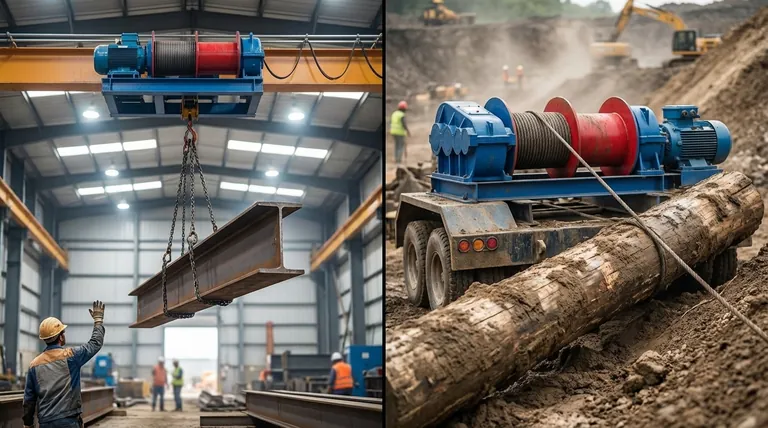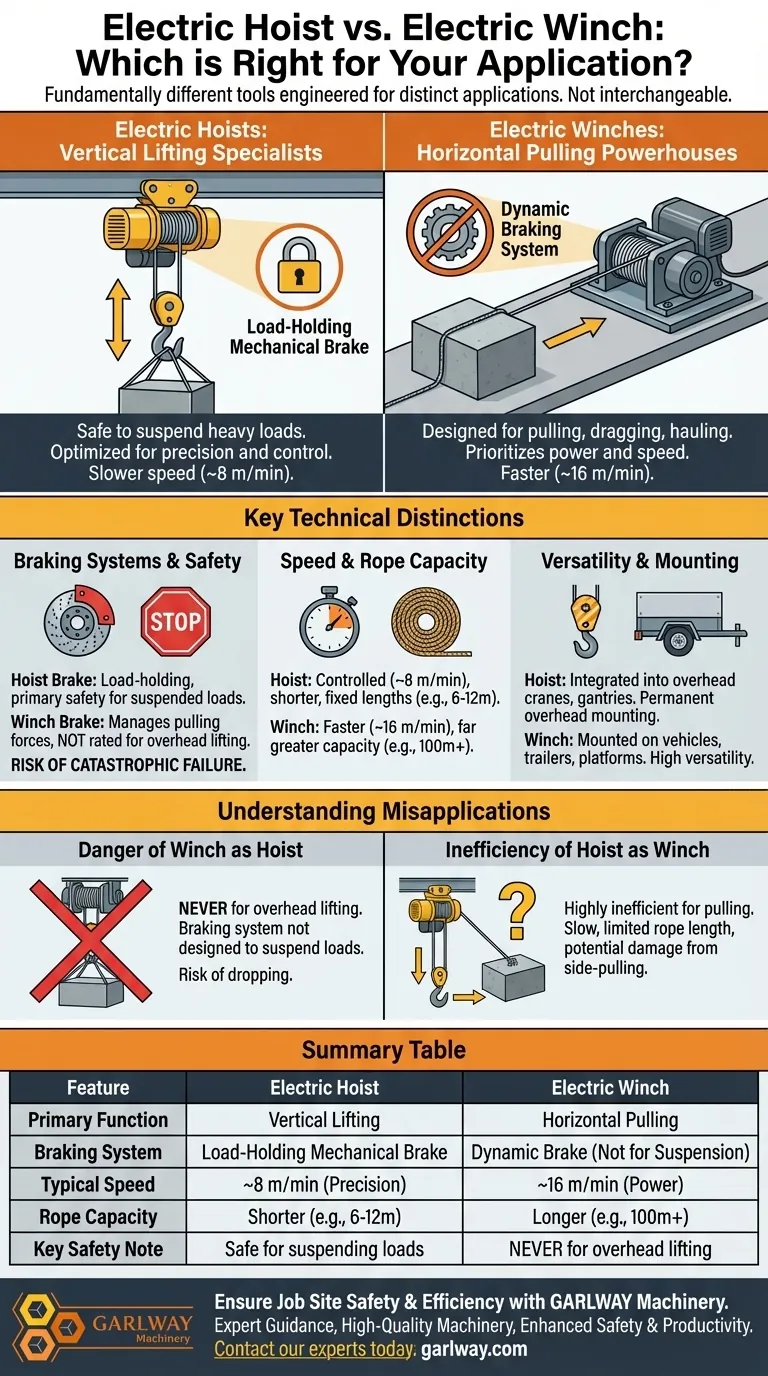The short answer is neither is "better"—they are fundamentally different tools engineered for distinct applications. An electric hoist is purpose-built for the precision and safety of vertical lifting and suspending loads. An electric winch, in contrast, is designed for the high-power demands of horizontal pulling or dragging. Using the wrong tool for the job is not only inefficient but critically unsafe.
The core distinction comes down to the braking system and the intended direction of force. A hoist is designed to safely suspend a load in mid-air, while a winch is designed to pull a load across a surface. Confusing the two can lead to catastrophic equipment failure.

The Core Difference: Lifting vs. Pulling
To make the right choice, you must first understand the fundamental design philosophy behind each device. They solve two very different mechanical problems.
Electric Hoists: The Vertical Lifting Specialists
An electric hoist is exclusively designed for moving loads straight up and down. Its entire construction, from the gearing to the braking system, is optimized for this single purpose.
The key feature is a load-holding mechanical brake. This brake is engineered to automatically engage and hold the load securely the moment the motor stops. This makes it safe to suspend heavy objects in the air for extended periods.
They are built for precision and control, often operating at slower speeds to allow for careful positioning of sensitive or heavy materials.
Electric Winches: The Horizontal Pulling Powerhouses
An electric winch is a powerhouse for pulling, dragging, or hauling loads horizontally or up an incline. They are commonly seen on vehicles for recovery or on trailers for loading equipment.
Winches typically use a dynamic braking system. This system is designed to stop the drum from turning and resist the pulling force, but it is not intended or rated for suspending a load overhead. Relying on a winch's brake to hold a load in the air is a significant safety risk.
They prioritize power and speed over the pinpoint precision of a hoist, often featuring much longer cables and faster line speeds to cover distances efficiently.
Key Technical Distinctions
Beyond the primary function, several technical differences dictate which tool is appropriate for your task.
Braking Systems and Safety
This is the most critical distinction. A hoist's brake is its primary safety feature for suspended loads. It prevents gravity from causing a load to drop.
A winch's brake is designed to manage the forces of a pull. It can prevent a vehicle from rolling back down a hill but is not engineered to withstand the unique, constant stress of a vertically suspended load. Overheating and failure are real possibilities if misused.
Speed and Rope Capacity
Winches are generally much faster. A typical winch might have a line speed of 16 meters per minute, while a comparable hoist operates at a more controlled 8 meters per minute.
Winches also offer far greater rope capacity, often carrying 100 meters or more of wire rope. Hoists have much shorter, fixed lengths (e.g., 6 or 12 meters) suited for a specific vertical lifting height.
Versatility and Mounting
Winches are champions of versatility. They can be easily mounted on vehicles, trailers, or other stationary platforms for a wide range of pulling tasks.
Hoists are typically integrated into a larger lifting system, such as an overhead crane, gantry, or I-beam trolley. Their mounting is more permanent and engineered specifically for overhead safety.
Understanding the Misapplications
Using these tools interchangeably is a common but dangerous mistake. Understanding why will protect your equipment and, more importantly, your personnel.
The Danger of Using a Winch as a Hoist
Never use a winch for overhead lifting. The braking system is not designed to suspend a load, and the gear train is not built to handle the direct, unsupported force of gravity. A failure in either system would result in the load dropping immediately.
The Inefficiency of Using a Hoist as a Winch
While less dangerous, using a hoist for pulling is highly inefficient. Its slow speed will make the task take much longer, and its short rope length severely limits its utility. Furthermore, side-pulling can cause the rope to wrap unevenly on the drum, potentially damaging the hoist and the rope itself.
Making the Right Choice for Your Application
Base your decision on the primary direction of force required for your task.
- If your primary focus is overhead vertical lifting: You must use an electric hoist. Its load-holding brake and design are non-negotiable for safety and control.
- If your primary focus is horizontal pulling or dragging: An electric winch is the correct, more powerful, and more efficient tool for the job.
- If you are mounting equipment on a vehicle for recovery or loading: A winch is the industry standard designed specifically for these high-traction applications.
- If you need to lift and then traverse a load horizontally: You need a complete crane system, which uses a hoist mounted on a movable trolley.
Choosing the correct equipment is the first and most critical step toward a safe and successful operation.
Summary Table:
| Feature | Electric Hoist | Electric Winch |
|---|---|---|
| Primary Function | Vertical Lifting | Horizontal Pulling/Dragging |
| Braking System | Load-Holding Mechanical Brake | Dynamic Brake (Not for Suspension) |
| Typical Speed | ~8 m/min (Precision Control) | ~16 m/min (Power & Speed) |
| Rope Capacity | Shorter (e.g., 6-12m) | Longer (e.g., 100m+) |
| Key Safety Note | Safe for suspending loads overhead | NEVER use for overhead lifting |
Ensure Job Site Safety and Efficiency with the Right Equipment
Choosing between a hoist and a winch is critical for the safety of your personnel and the success of your project. GARLWAY specializes in providing robust and reliable construction machinery, including electric hoists for precise vertical lifting and electric winches for powerful horizontal pulling.
We help construction companies and contractors globally by providing:
- Expert Guidance: Our team will help you select the perfect tool for your specific lifting or pulling application.
- High-Quality Machinery: Durable hoists, winches, concrete mixers, and batching plants built for demanding job sites.
- Enhanced Safety & Productivity: The right equipment minimizes risk and maximizes operational efficiency.
Don't risk using the wrong tool. Contact our experts today to discuss your needs and get a personalized solution from GARLWAY.
Visual Guide

Related Products
- Electric Hoist Winch Boat Anchor Windlass for Marine Applications
- Electric 120V Boat Winch by Badlands
- 12000 lb Heavy Duty Electric Boat Winch
- Heavy Duty Electric Boat Winch Windlass Anchor
- Electric and Hydraulic Winch for Heavy Duty Applications
People Also Ask
- What are the benefits of consistent lifting power in electric hoists? Boost Productivity & Safety
- What are the pros and cons of electrical winches? Make the Right Choice for Your Project
- What are the advantages of an electrically operated trailer winch? Enhance Safety & Control for Your Trailer
- What adjustments are necessary for the hoist winch's main controller? Achieve Sub-1 cm Lifting Precision
- Why won't my electric hoist go up or down? A Step-by-Step Troubleshooting Guide



















